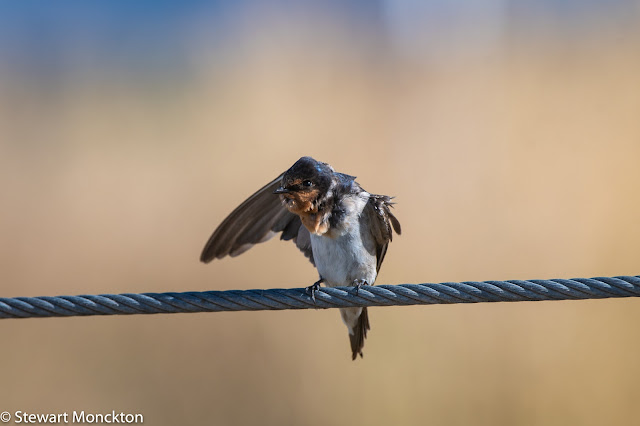Wednesday, 26 January 2022
Wild Bird Wednesday 496 - Blue Bonnet
Wednesday, 19 January 2022
Wild Bird Wednesday 495 - Brown-headed Honeyeater
Just to prove that not all Australian birds are outrageously bright, here are some Brown-headed Honeyeaters (Melithreptus brevirostris) from NW Victoria.
This bird is widespread along much of southern Australia - and occurs in a range of subspecies, but I am not confident to identify this species to such a level! These birds came in to drink at a water point / hide on a patch of native bush nr. Patchewollock - a tiny town with wonderful resident bird life to be found around it.
This bird is about 12 or 13cm long, and this is the first time I have managed to photograph them. I am growing more fond of hides by the day!
As ever, you can join in with WBW by clicking on the link below. Cheers, and stay well. SM
You are invited to the Inlinkz link party!
Click here to enterTuesday, 18 January 2022
Red (and Blue) Kangaroo
"The Red Kangaroo (Osphranter rufus) is the largest of all kangaroos, the largest terrestrial mammal native to Australia, and the largest extant marsupial".
So says Wikipedia, and who am I to argue.
These Kangaroos were photographed in the Wyperfeld National Park - which is in the NW of Victoria. This part of the state is badged as Victoria's Outback - and it does have the feel of a more remote and dry part of the world.
The redder of these 'roos is the male and the one with the greyer chest is the female. The females can look very blue/grey at times and are often called "Blue Fliers". Males are called Big Reds!
The males are an impressive beast to say the least - Males can have a head-and-body length of 1.3–1.6 m (4.3–5.2 ft) and the tail adds up to 1.2 m (3.9 ft) to the total length.
You can see more pictures from around the world at Wordless Wednesday and Our World Tuesday.
Wednesday, 12 January 2022
Wild Bird Wednesday 494 - Brolga
This has not happened in about two years, but I will be away this week! So, I am setting up WBW494 early.
About a week about I went down to Werribee, on a rather sunny and windy day. I was hoping to find a pair of Brolga (Antigone rubicunda) which is one of the two species of crane found in Australia. This species is found over much of northern and eastern Australia. They stand over a meter in height, and have a wing span of over 2m. They are a big bird.
However, being big did not make them easy to find at the start of the day - and by the time I had tracked then down, the perpetual summer problem of heat haze had reared its ugly head! This little family group also seemed to like being behind the seed head of thistles and other weeds!!
I stayed with the birds for about 1/2 hour and then let then be. It was a wonderful little period in what continues to be a difficult time. But the birds always help!
As you can see, this pair of birds has a well developed youngster with them. It was still being fed by the adults, but was about the size of a small dog!
As ever, to join in with WBW click on the blue button.
I managed to visit a number of blogs this week - but found it hard to comment on some. In some cases I could not write in the 'comment box' at the end of a post. Is anyone else having issues like this?
Cheers SM
You are invited to the Inlinkz link party!
Click here to enterWednesday, 5 January 2022
Wild Bird Wednesday 493 - Welcome Swallow
I thought this was an appropriate bird with which to start the New Year of WBW!
So, its a Welcome Swallow (Hirundo neoxena). We have this Swallow with us in SE Australia all year round, and although it is less common in winter, its presence is not the sign of spring it is with other species of Swallows.
I can only image that this species has had a good breeding season as there were 100s if not 1000s of them at the Western Treatment plant. There were also large numbers of Fairy Martins as well, and one has sneaked into one of the pictures.
I know I have been shockingly bad at visiting other blogs of late - this (insert swear word of choice) Covid situation has got inside my head in a bad way, and the numbers here do not make for pleasant reading.
Anyway - I try to get back to some form of normal soon.
In the mean time, please link up and comment, and feel free to share the WBW page with new bloggers who you know, or ones that you think have forgotten about this little community. SM
You are invited to the Inlinkz link party!
Click here to enter






























